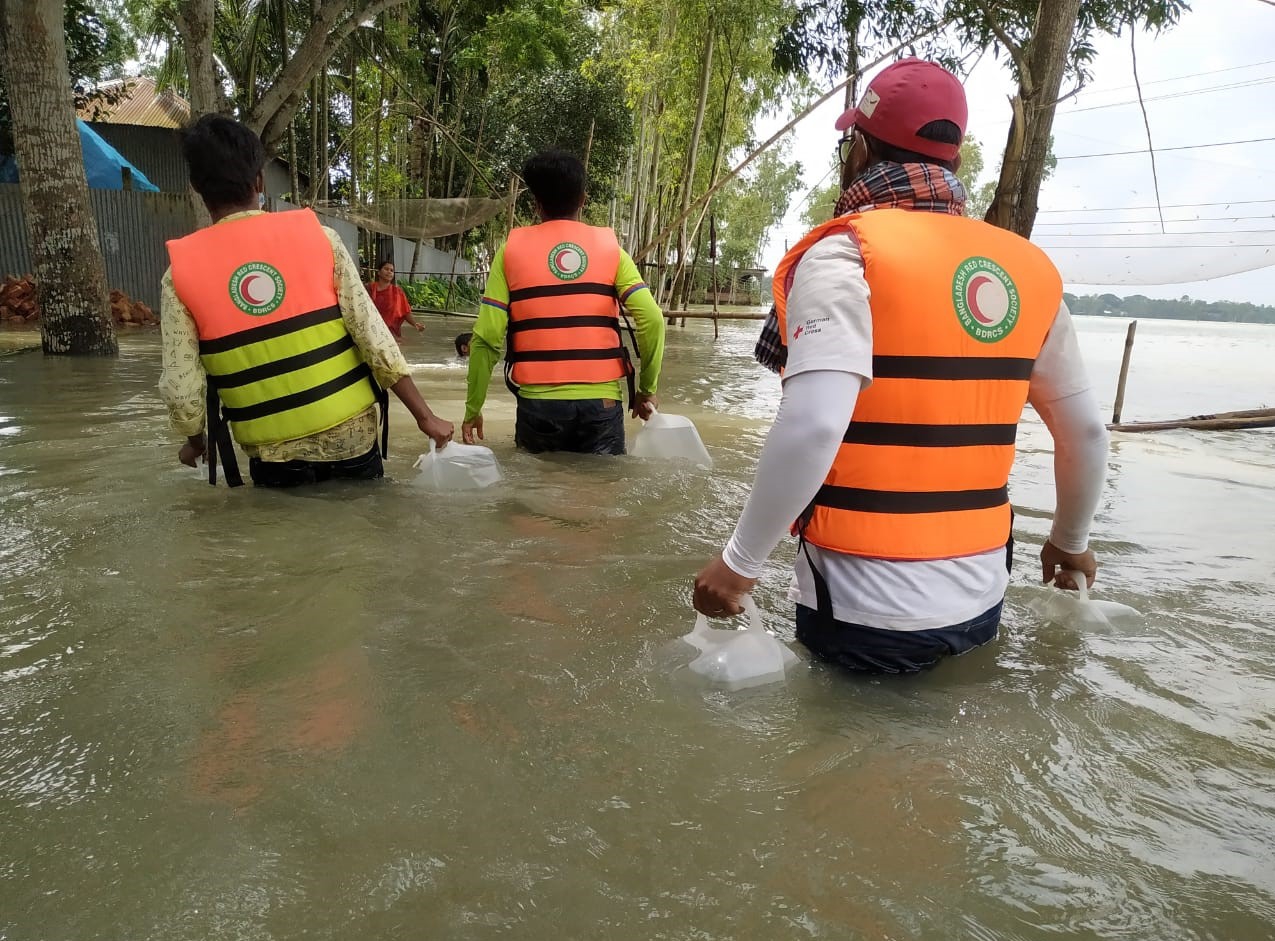How Digital Transformation in Humanitarian Assistance is Impacting the Global COVID-19 Response.

Preserving the four principles of humanity, impartiality, neutrality, and independence, generally referred to as the humanitarian principles, is vital when facing new and emerging challenges in a broadening humanitarian agenda. Pre-COVID-19, humanitarian assistance had already spurred a massive effort to energize vulnerable communities to become more resilient. The COVID-19 pandemic has however amplified pre-existing risks for many communities from escalating conflicts and lessening access to international aid and relief, while creating new risks for the humanitarian sector.
The International Committee of the Red Cross (ICRC) Health Care in Danger initiative recorded “over 600 cases of violence, harassment or stigmatization in relation to cases of COVID-19 against humanitarian assets between March and July 2020. For the Head of this initiative, Maciej Polkowski[i], “this pandemic has put healthcare workers directly in harm’s way at a time when they are needed most.” With increased barriers to accessing natural disaster and combat zones, humanitarian assistance must transform accordingly to deliver a set of collective and system-wide actions and efforts.
Pre-pandemic, the IFRC and American Red Cross (ARC) had already engaged in a massive changing pattern of digital tools usage, including digital cash, virtual engagement of Red Cross Red Crescent National Societies, distance learning/training of volunteers, increased capacity for teleworking and teleconferencing. The pandemic has enhanced and re-focused the urgency to transform, triggering a reset for the humanitarian cluster, from piloting to mainstreaming participatory and anticipatory humanitarian assistance.
The International Monetary Fund (IMF)[ii] cites digital technology as the winner of the COVID-19 crisis, creating new opportunities to accelerate and enhance more inclusive and resilient global communities, amid social distancing and containment measures. While the current COVID-19 pandemic has raised many questions and dilemmas for the global humanitarian community, there are some ways that the digital transformation in humanitarian assistance is thriving in the pandemic.
1. Multi-use of the telemedicine platform: The digital infrastructure benefits societies beyond health, including e-government, e-commerce, and eLearning.
For the World Health Organization (WHO), the criteria for developing countries to rebound from the Covid-19 crisis will be three-fold: their medical capacity to treat the sick, their contact tracing capabilities and access to diagnostics, therapeutics, and vaccines. International humanitarian and aid organizations are considered key partners in the global collaboration “to accelerate the development, production and equitable access to new COVID-19 diagnostics, therapeutics and vaccines under the Access Covid-19 Tools (ACT) accelerator[iii]”, from their on-the-ground presence and expertise[iv].
Despite being in vulnerable high-risk communities, Health-care professionals in urban and rural areas have been able to provide community-specific health services and information through mobile telemedicine solutions. Telemedicine facilitates long-distance patient and clinician contact, care, advice, reminders, education, intervention, monitoring, and even remote admissions. By August 2020, American Red Cross’ International Services Department (ISD) provided virtual mental health support and psychosocial first aid training to 2,790 host National Societies staff. With telemedicine, programs that would have been expensive to implement in developing countries, the WHO has recommended building multiple usage programs on existing resources and infrastructures.
2. Safer Data Usage – Enabling the control of COVID-19 without excessive control of the people.
Multiple data privacy challenges arise with the prospect of contact tracing, privacy, and data protection. The extension of universal broadband access in underserved communities presents an asset to track these communities and the larger population, but it comes with concerns for civil liberties and potential privacy trade-offs. Many developed countries have engaged digital technology networks and mobile phone usage as public health tools in contact tracing. Localized data access of mobile data is invaluable to public health authorities to better collect and share information with local governments and potential donors.
Intelligence tools are also being deployed for contact tracing and pandemic mitigation, with significant safeguards to prevent invasive infringement of privacy, including exposure notification, scale contact tracing technology. Nonetheless, the risk of creating dangerous centralized repository data remains, as enabling a culture of monitoring and usage beyond the initial pandemic needs. To ensure safe data usage the World Health Organization (WHO) recommends “fostering global, national, and regional collaboration and partnerships with private and nongovernmental sectors with the protection of legally binding agreements, by supporting forums on telemedicine to inform policy-makers and users of telemedicine programs on telemedicine applications, best practice, and evaluation”.
3. Expanded Multi-Stakeholder Collaboration: Enhancing the Red Cross Movement Partnership, and the larger stakeholder sphere.
Covid-19 has limited humanitarian response, but disasters and conflicts remain, challenged by unpredictable pandemic peaks and restrictions from local governments. Within this context, data sharing across the movement can facilitate complementary response plans to better foresee challenges, build likely scenarios through joint risk analysis, virtual interplay, and scenario building. This transformation may also incentive donors’ contributions with private donors, the UN Foundation, the Gates Foundation, or the WHO, to strengthen partnerships beyond fiscal success.
For Koby Langley, American Red Cross’ Senior Vice President of International Services and Service to the Armed Forces and International Humanitarian Law, Covid-19 has been a game changer. Fortuitously “new technologies brought new opportunities to collectively mobilize resources on behalf of the movement, beyond the Federation, toward a collective movement partnership, mobilizing localization capabilities and enhancing push response mechanisms of the Federation to transform the movement service delivery model”. In August 2020, Langley shared with his team his vision of the digital technology’s potential for International Humanitarian Law (IHL) to become the norm among IFRC and National Societies in conflict zones, “educating children and youth on the rules of engagement, the laws of wars and IHL. Langley sees digital technology as a vector to support virtual youth action campaigns and centers for creativity to reach out to schools and volunteers in conflict zones, “to create a young, energized, mobilized, excited and activated movement to promote and respect IHL for the future generations”.
4. Heightened Engagement of Digital Tools: Maximizing on Technology to Strengthen Preparedness and Resilience.
Humanitarian organizations already knew how to maintain essential services with sufficient funding, supplies, and human resources in low-resource, vulnerable, or high-risk settings. But the pandemic has pressed humanitarian clusters to work together across sectors, under a dual timeframe of immediacy and long-term outcomes. By August 2020, ISD supported its National Society partners with response and contingency planning and implementation with Covid-19 information management, reporting, and data visualization. ISD established agreements with financial service providers, enhancing National Societies’ cash program capacity, reaching out to 8,820 households.
Through an enhanced use of digital technology, the humanitarian cluster has improved its capacity to better assess and offset the vulnerability index and COVID-19 risk in priority countries. The outcome includes assessing risks to quickly decode new outbreaks; monitor access to water and sanitation; connect schools to enhance educational experiences; help government-related meetings and planning; and, draft and distribute multilingual of non-specialized training, preparedness guidelines and guidance.
CONCLUSION
The pandemic has brought to the forefront the acute deficits of humanitarian aid protocols in protracted emergency settings. Many of the deep-rooted vulnerabilities have been tabled and addressed with the capabilities of new and emerging digital tools. However, this new model of a modern democratic network society with health concern needs, must rely on a set of principles to ensure a strong and safe local community level engagement. By optimizing the scale, scope and connectivity at the hyper local level unique to the movement, IFRC and ARC are on the frontlines of this transformation, with the ability to help to build modern, resilient support networks, while providing relevant, direct and continuous community-based mission support.
[i]More than 600 acts of violence committed in connection to COVID-19: International Red Cross, Reuter World News, August 19, 2020
https://www.reuters.com/article/us-health-coronavirus-violence-idUSKCN25F2EQ
[ii] Digital Financial Inclusion in the Times of COVID-19, IMFBlog, July 2020.
https://blogs.imf.org/2020/07/01/digital-financial-inclusion-in-the-times-of-covid-19/
[iii] Coronavirus Global Response: Access to COVID-19 Tools-Accelerator Facilitation Council holds inaugural meeting, September 11, 2020
https://guardian.ng/apo-press-releases/coronavirus-global-response-access-to-covid-19-tools-accelerator-facilitation-council-holds-inaugural-meeting/
[iv] European leaders join forces to combat Covid-19, The Guardian, May 3rd, 2020
https://www.theguardian.com/world/2020/may/03/european-leaders-join-forces-to-combat-covid-19



